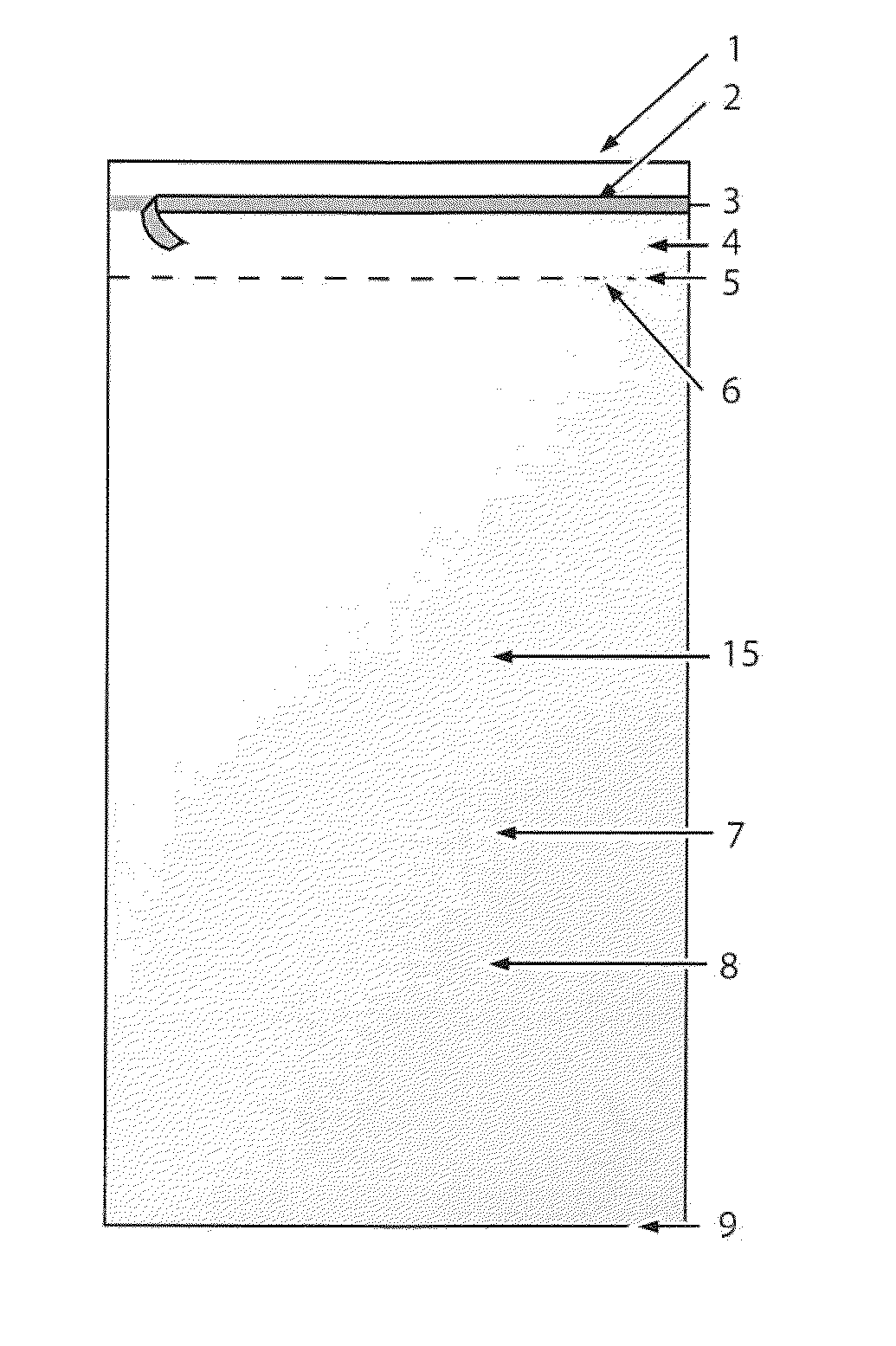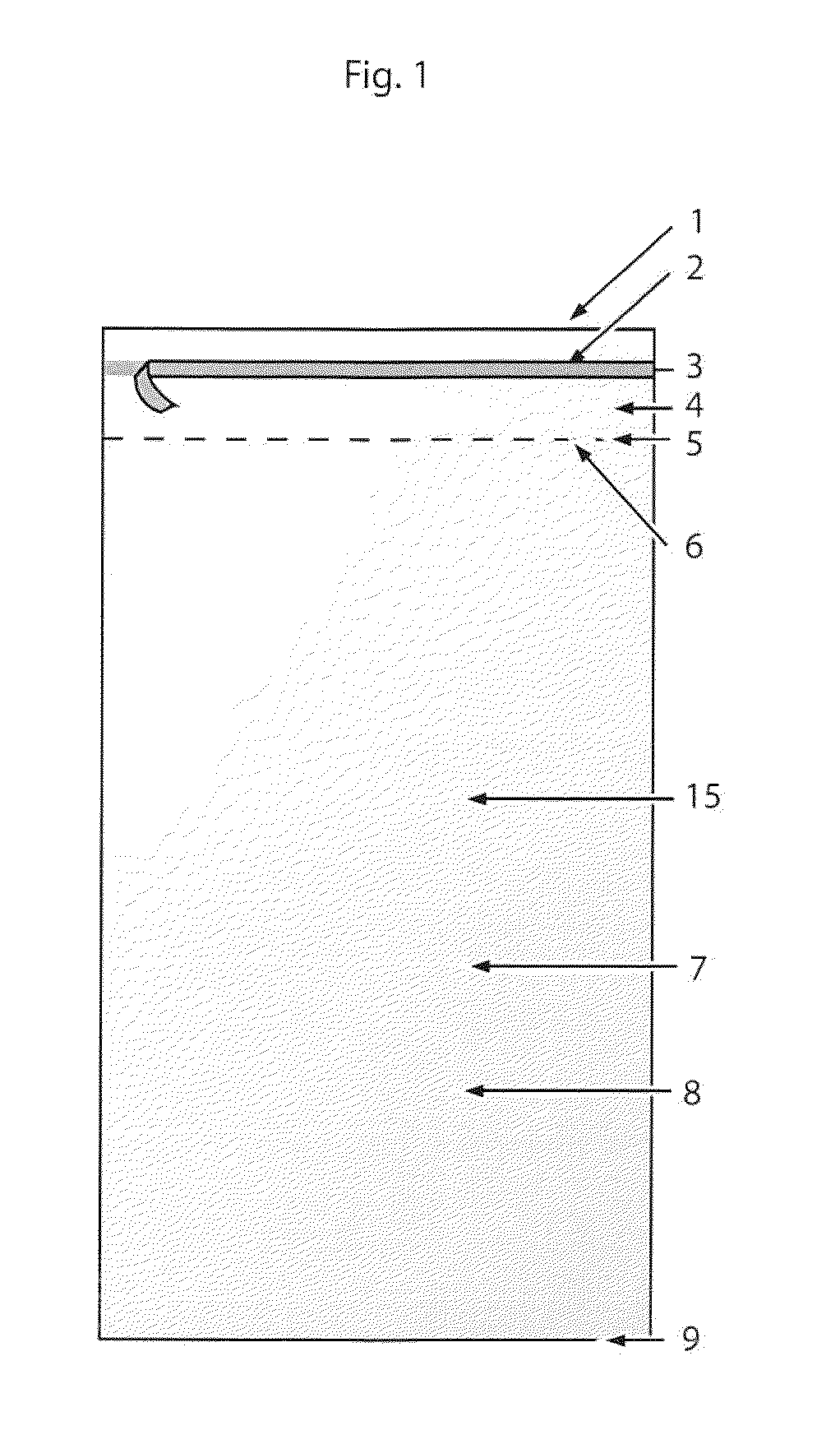[0043]The bag package member is dispensed by a common element capable of containing large quantities of bags for convenient easy dispensing which allows for the product to be readily and consistently available. The bags are separable and independently
usable. In the past,
wax paper bags have been offered but there has been a problem with dispensing multiple bags. The invented packaging system resolves the problem of dispensing as the packages are available in large quantities ensuring more consistent availability; in addition, the package is more sanitary because the user will only touch the package to be used by them. The package is opaque for discreet disposal. People tend to be embarrassed of others viewing their used or soiled
personal hygiene products and will often attempt to flush them in an attempt to hide them from view which can result in disastrous plumbing issues. Because the surface of the package has a desired nondescript aesthetic configuration or appearance, the invention solves the issue of embarrassment because once the package is used, items are sealed within and can be discarded without drawing attention to the package and because it is opaque, others will not be able to view contains contained therein.
[0053]Due to the difficulty in disposing of blood-soaked items without
staining clothing, toilets, hands, etc., women tend to wrap them in
toilet paper. This may not sound like much of a problem, but it adds up over time. It is estimated that each woman uses a roll of
toilet paper each month in order to dispose of used
personal hygiene products. The said invention eliminates the need to use
toilet paper at all to wrap the items, since the items can be dropped into the bag and sealed. Also, the strong, opaque bags are not see-through, so they are not embarrassing to use in a public restroom, allowing for discreet disposal. In addition, the water wasted to flush the items and the flooding caused when they do not flush properly is avoided. Even more importantly, the items and their contents are in a tidy bag, and not on the floor nor flushed in the toilet.
[0055]In addition to
cutting back on the waste of
toilet paper and water, the said invention prevents the disposal of used personal care products into sewer and septic systems, and prevents them from entering the environment, polluting waterways and affecting
wildlife. Also, there is less of a burden on
wastewater treatment systems, less damage to
sewage treatment systems and a decrease of solids in septic tanks—reducing those costs to both businesses and municipalities in the long term.
[0057]Conventional plastics do not break down.
Litter and landfill waste can take decades to degrade. In landfills, not only do ordinary plastics degrade very slowly but also anything contained within them may not reach their full degradation potential. This results in a needless waste of valuable landfill space. The said invention is created using degradable plastic which does not require a
biological process to degrade. Microorganisms will speed up the
degradation process, but they're not required. The degradation time varies depending on the amount of
exposure to degradation promoters (
sunlight, heat, and microorganisms). This is an optimal situation for consumers. The plastic degrades quickest in the exact situation we want it to: when it becomes
litter. If the plastic is used properly it will last many years, but once it becomes
litter it could degrade in under 12 months.
[0059]Paper bags require 40-70 percent more energy to manufacture than plastic. Utilizing degradable plastic bags reduces
greenhouse emissions. Paper bags double emissions, double the energy use and create 80 percent more waste than degradable plastic bags. Degradable plastic bags have a much lower environmental
footprint in manufacturing. One of the factors that accounts for this is the difference in weight between a typical paper and
plastic bag, with paper bags weighing 10 times as much as their plastic counterparts on average. Therefore, shipping and storage of degradable plastic bags is more cost effective and uses less energy.
[0063]The invented packaging system is dispensed from a container wherein content items are joined together and easily separated at the
time of use, making the subsequent package readily available for the next user. The invented bag packaging system resolves the problem of dispensing because the packages are available in large quantities directly to the user at the time of need. In addition, the package is sanitary as the user will only touch the package to be used.
 Login to View More
Login to View More 


